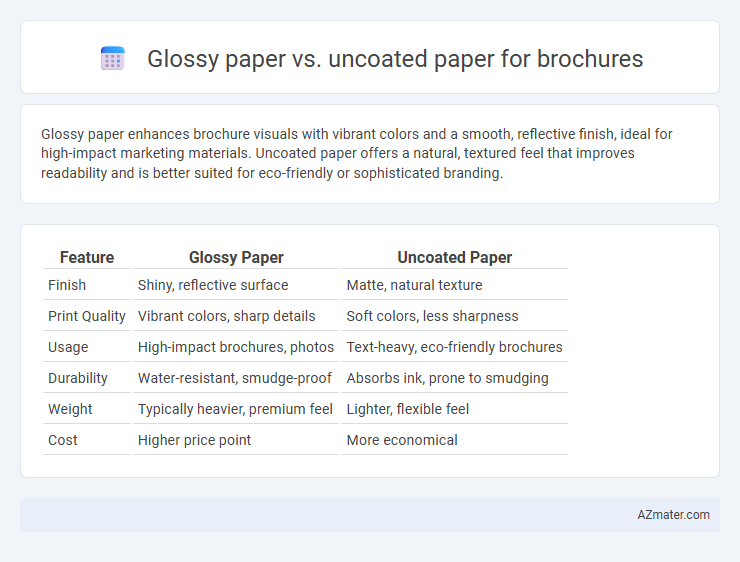Glossy paper enhances brochure visuals with vibrant colors and a smooth, reflective finish, ideal for high-impact marketing materials. Uncoated paper offers a natural, textured feel that improves readability and is better suited for eco-friendly or sophisticated branding.
Table of Comparison
| Feature | Glossy Paper | Uncoated Paper |
|---|---|---|
| Finish | Shiny, reflective surface | Matte, natural texture |
| Print Quality | Vibrant colors, sharp details | Soft colors, less sharpness |
| Usage | High-impact brochures, photos | Text-heavy, eco-friendly brochures |
| Durability | Water-resistant, smudge-proof | Absorbs ink, prone to smudging |
| Weight | Typically heavier, premium feel | Lighter, flexible feel |
| Cost | Higher price point | More economical |
Introduction to Glossy and Uncoated Paper
Glossy paper features a smooth, shiny finish that enhances color vibrancy and image sharpness, making it ideal for brochures that require a high-impact visual appeal. Uncoated paper has a matte, natural texture that offers a more tactile, professional feel and reduces glare, suitable for brochures emphasizing text clarity and readability. Understanding these distinct characteristics helps businesses select the best paper type to align with their branding and messaging goals.
Key Differences Between Glossy and Uncoated Paper
Glossy paper features a shiny, reflective finish that enhances color vibrancy and sharpness, making images and text appear more vivid, while uncoated paper has a matte, natural texture that absorbs ink for a softer, muted look. Glossy brochures are more resistant to moisture and fingerprints, whereas uncoated brochures offer better writeability and a more tactile feel that promotes a premium, artisanal impression. The choice between glossy and uncoated paper impacts print quality, durability, and user interaction, influencing the overall perception and purpose of marketing materials.
Visual Appeal: Glossy vs Uncoated Brochures
Glossy brochures offer vibrant colors and sharp images, creating a high-impact visual appeal that captures attention effectively. Uncoated brochures provide a more natural, tactile feel with a subdued finish, enhancing readability and conveying an organic, professional look. Choosing between glossy and uncoated depends on whether bright, eye-catching visuals or a textured, elegant appearance is desired for the brochure.
Color Vibrancy and Image Quality Comparison
Glossy paper enhances color vibrancy by producing sharp, vivid images with a reflective finish that intensifies contrast, making photos and graphics stand out in brochures. Uncoated paper, with its matte surface, offers softer color tones and reduced glare, which can be preferable for textual content but may cause images to appear less vibrant and slightly muted. For high-impact visual appeal in marketing materials, glossy paper provides superior image quality, while uncoated is ideal for a natural, tactile feel with subtler visuals.
Texture and Tactile Experience
Glossy paper offers a smooth, polished texture that enhances colors and images, creating a vibrant and eye-catching brochure. Uncoated paper provides a natural, matte finish with a slightly rough surface, delivering a tactile and organic feel that conveys authenticity. The tactile experience of uncoated paper promotes a sense of warmth and approachability, while glossy paper emphasizes sleekness and modernity.
Durability and Longevity in Brochure Printing
Glossy paper offers superior durability and longevity in brochure printing due to its smooth, coated surface that resists moisture, stains, and wear, preserving vibrant colors and sharp images over time. Uncoated paper, while providing a natural texture and matte finish, is more prone to smudging, fading, and damage from handling or environmental exposure, reducing the lifespan of the brochure. For long-lasting promotional materials, glossy paper is often preferred for maintaining print quality and durability under frequent use.
Writing and Printing Compatibility
Glossy paper offers superior ink absorption and vibrant color reproduction, making it ideal for high-resolution images and detailed graphics in brochures. Uncoated paper provides excellent compatibility with various writing instruments, including pens and markers, allowing for easy note-taking or personalization. Choosing between glossy and uncoated paper depends on whether the priority is vivid printing quality or additional writing functionality.
Cost Considerations: Glossy vs Uncoated Paper
Glossy paper typically costs more due to its coated finish that enhances color vibrancy and adds a premium look, making it ideal for high-impact brochures. Uncoated paper, being less expensive, offers a natural texture and is more budget-friendly for large print runs or informational brochures. Choosing between the two depends largely on the desired visual effect and overall marketing budget constraints.
Eco-Friendliness and Sustainability
Glossy paper often involves chemical coatings and plastic films that hinder recyclability, while uncoated paper is typically more biodegradable and easier to recycle, making it a more eco-friendly choice for brochures. Uncoated paper generally uses fewer additives and consumes less energy during production, contributing to a smaller carbon footprint. Choosing uncoated paper supports sustainable printing practices by reducing environmental impact and promoting the use of renewable materials.
Choosing the Right Paper for Your Brochure Needs
Glossy paper enhances brochure visuals with vibrant colors and a shiny finish, making it ideal for marketing materials requiring high-impact imagery and a professional look. Uncoated paper offers a natural, tactile feel with excellent readability and is perfect for brochures focusing on eco-friendliness or a sophisticated, understated design. Selecting the right paper depends on your brochure's purpose, budget, and desired aesthetic, balancing vibrancy against texture and user experience.

Infographic: Glossy paper vs Uncoated paper for Brochure
 azmater.com
azmater.com